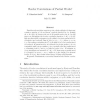Free Online Productivity Tools
i2Speak
i2Symbol
i2OCR
iTex2Img
iWeb2Print
iWeb2Shot
i2Type
iPdf2Split
iPdf2Merge
i2Bopomofo
i2Arabic
i2Style
i2Image
i2PDF
iLatex2Rtf
Sci2ools
MST
2010
2010
Border Correlations of Partial Words
Partial words are finite sequences over a finite alphabet A that may contain a number of “do not know” symbols denoted by ’s. Setting A = A ∪ { }, A∗ denotes the set of all partial words over A. In this paper, we investigate the border correlation function β : A∗ → {a, b}∗ that specifies which conjugates (cyclic shifts) of a given partial word w of length n are bordered, that is, β(w) = c0c1 . . . cn−1 where ci = a or ci = b according to whether the ith cyclic shift σi (w) of w is unbordered or bordered. A partial word w is bordered if a proper prefix x1 of w is compatible with a proper suffix x2 of w, in which case any partial word x containing both x1 and x2 is called a border of w. In addition to β, we investigate an extension β : A∗ → N∗ that maps a partial word w of length n to m0m1 . . . mn−1 where mi is the length of a shortest border of σi (w). Our results extend those of Harju and Nowotka.
| Added | 29 Jan 2011 |
| Updated | 29 Jan 2011 |
| Type | Journal |
| Year | 2010 |
| Where | MST |
| Authors | Francine Blanchet-Sadri, E. Clader, O. Simpson |
Comments (0)

